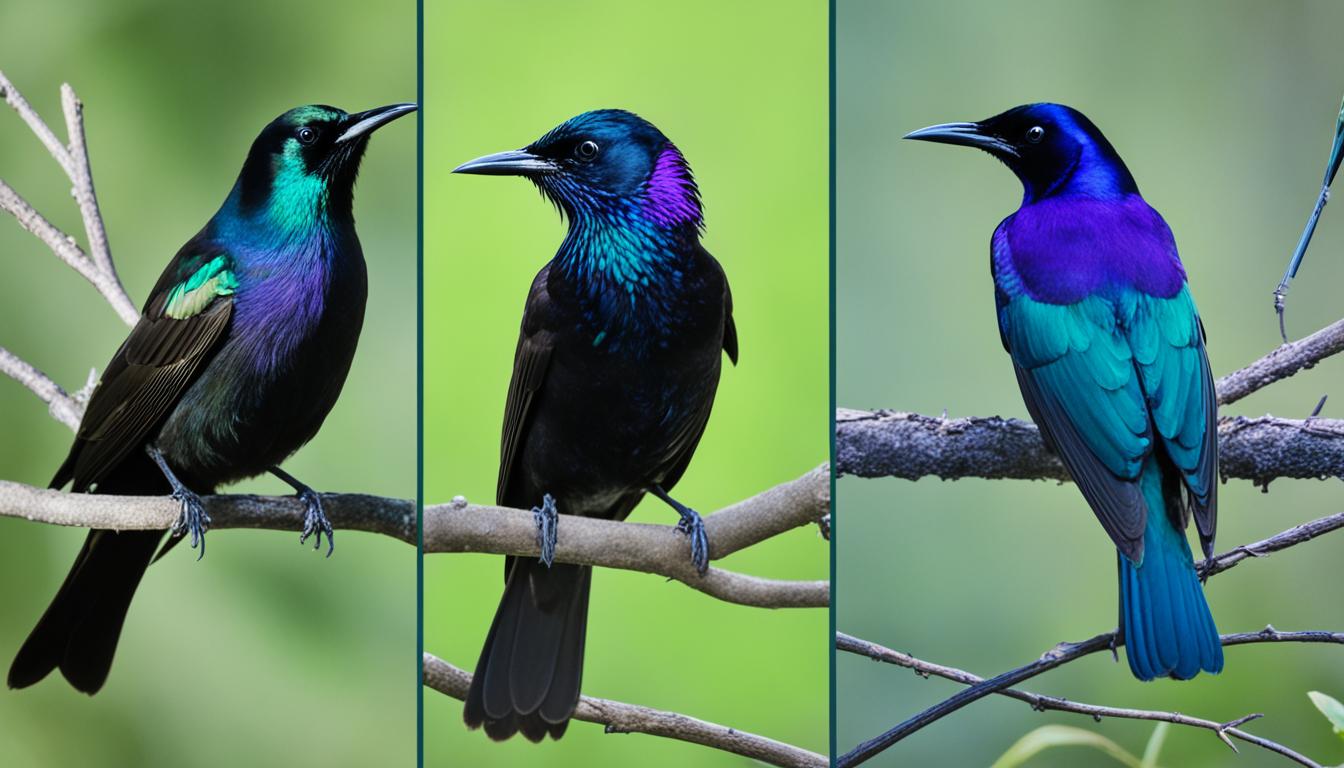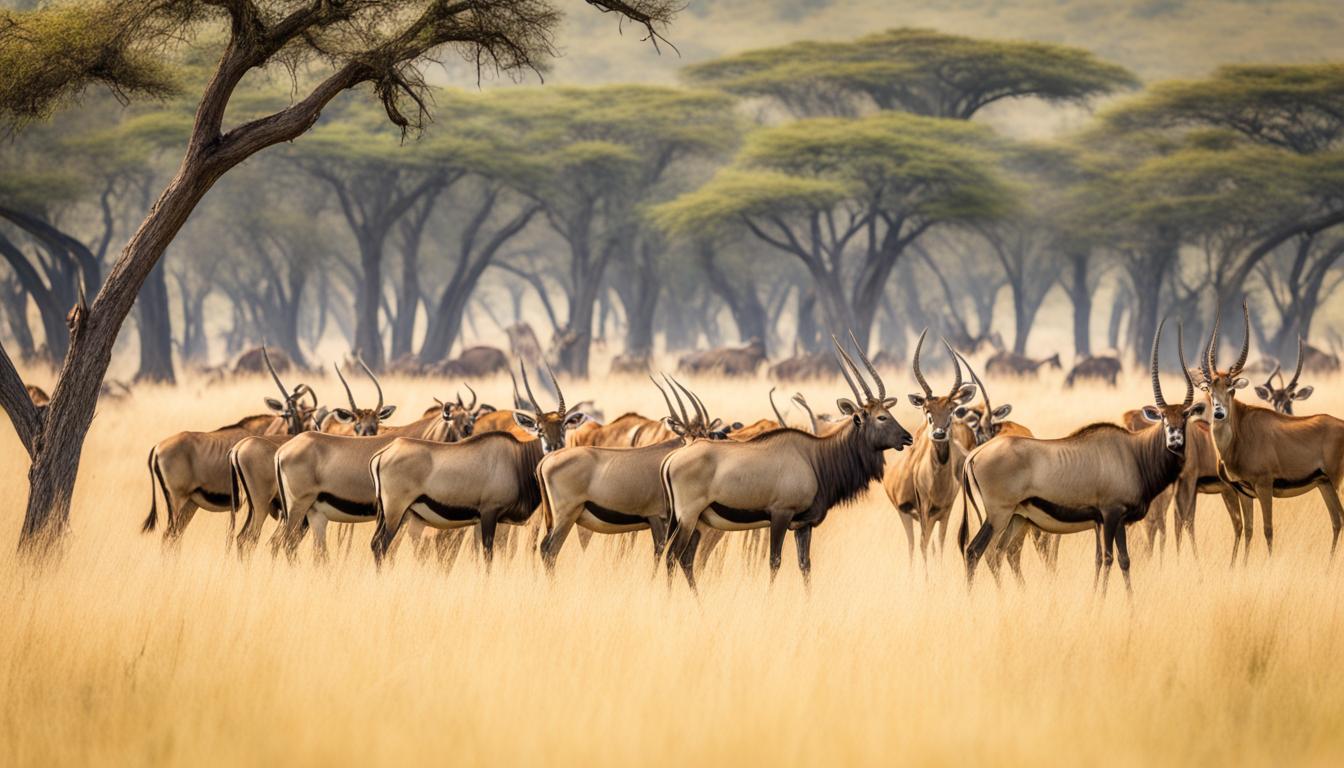Did you know that starlings and grackles are often confused with each other because they look so similar? These two types of birds have some traits in common that can make it difficult to tell them apart at first. This article will discuss the main distinctions between starlings and grackles to assist you in recognizing these interesting backyard birds easily.
Key Takeaways:
- Starlings and grackles have similar appearances, making it difficult to distinguish between the two.
- Understanding the unique characteristics of each species can assist in accurate identification.
- Grackles have shiny feathers, bluish heads, purple or bronze bodies, and yellow eyes.
- Starlings have dark feathers with purplish green iridescence, white spots in the winter, and thin yellow beaks.
- Both species can be aggressive at bird feeders, driving away other birds.
Grackle vs Starling Identification Basics
When it comes to identifying backyard birds, it’s important to understand the basics of distinguishing between common grackles and European starlings. While they may have some similarities in appearance, there are key characteristics that set them apart.
“Common grackles are blackbirds with lankier bodies, long tails, and dark legs. They have shiny feathers with a bluish head, purple or bronze body, and yellow eyes.”
If you spot a bird with these features, it is likely a common grackle. Their lanky body structure, long tails, and dark legs are distinctive. Pay close attention to their shiny feathers, bluish head, and vibrant purple or bronze body. The yellow eyes are another notable feature that helps in their identification.
“European starlings are blackbird-sized with dark feathers featuring purplish green iridescence and white spots in the winter. They have a long, thin yellow beak.”
On the other hand, European starlings are slightly bigger, similar in size to blackbirds. Look for their dark feathers that display purplish green iridescence, which can be particularly striking. In the winter, these feathers may have white spots. One characteristic that sets starlings apart is their long, thin yellow beak.
By understanding these identification basics, you’ll be better equipped to recognize and differentiate between grackles and starlings in your own backyard.
Take a look at the image below to see a visual representation of the distinguishing features of common grackles and European starlings:
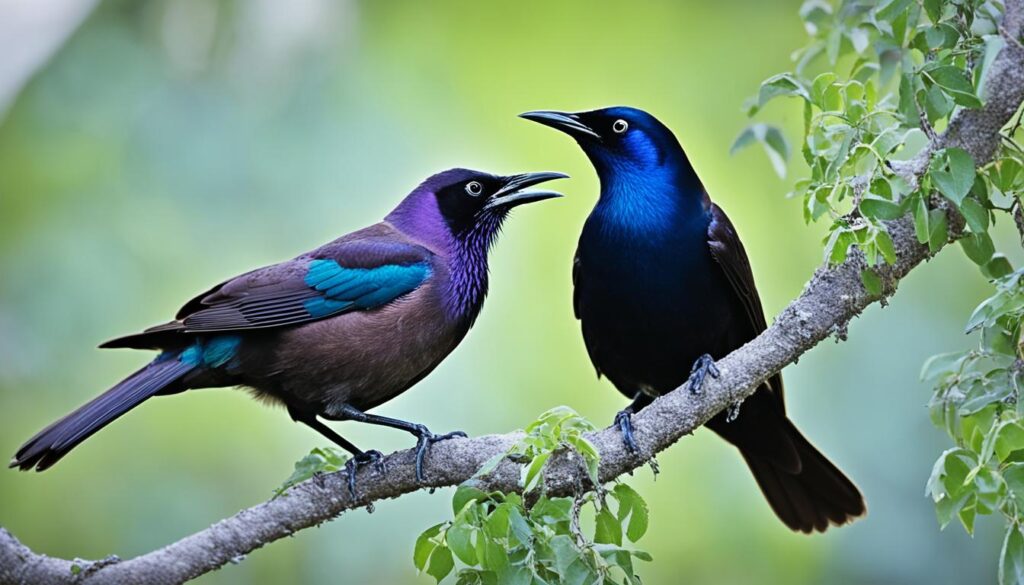
How to Identify a Common Grackle
To identify a common grackle, look for their shiny feathers with a bluish head, purple or bronze body, and yellow eyes.
Pay attention to their long tail, dark legs, and thick, dark, curved bills. Common grackles are a familiar sight in the eastern and midwestern U.S. year-round.
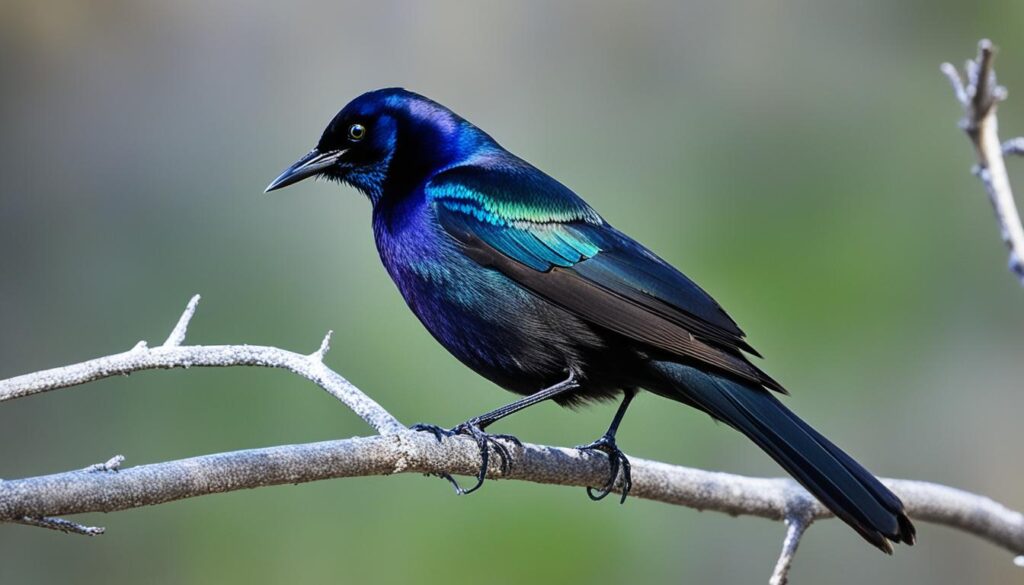
| Characteristic | Details |
|---|---|
| Feathers | Shiny with a bluish head, purple or bronze body |
| Eyes | Yellow |
| Tail | Long |
| Legs | Dark |
| Beak | Thick, dark, curved |
How to Identify a European Starling
To accurately identify a European starling, look for the following characteristics:
- Size: Similar to a blackbird, European starlings are medium-sized birds.
- Feathers: Their dark feathers have a distinctive purplish green iridescence and white spots, especially during the winter months.
- Wings: They have short, pointed wings.
- Tail: European starlings have relatively short tails.
- Legs: Their legs are pinkish in color.
European starlings were introduced to North America in 1890 and have since become a common sight throughout the United States and southern Canada all year round. Their adaptability and ability to thrive in various habitats have contributed to their widespread distribution.
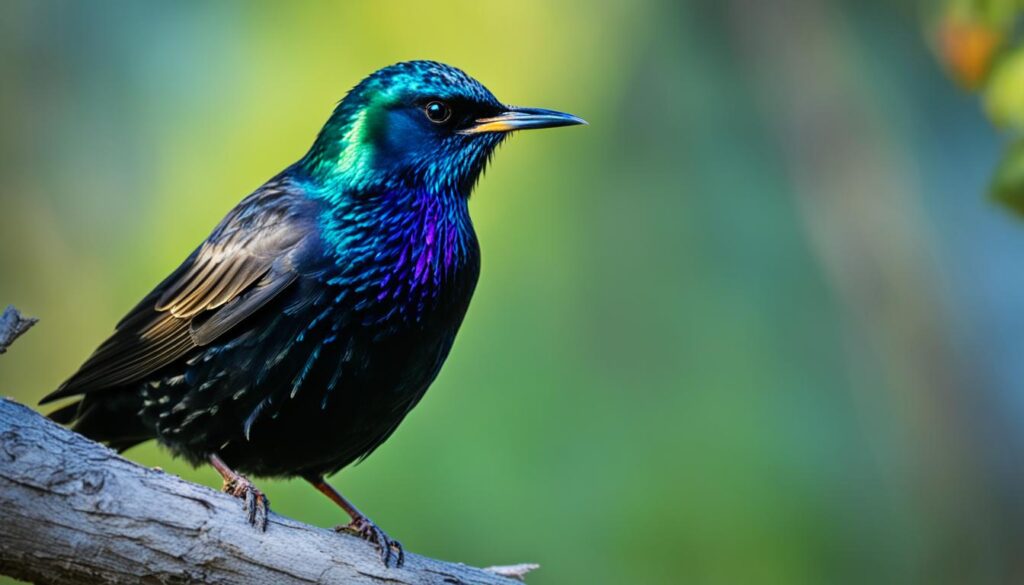
To further demonstrate the distinguishing features of a European starling compared to other birds, we have prepared the following table:
| Feature | European Starling | Common Grackle |
|---|---|---|
| Size | Medium-sized | Large |
| Feathers | Purplish green iridescence, white spots (winter) | Shiny feathers, bluish head, purple or bronze body |
| Wings | Short, pointed | Long |
| Tail | Short | Long |
| Legs | Pinkish color | Dark |
By carefully observing these key attributes, you can confidently identify a European starling and appreciate its unique characteristics.
Grackles and Starlings Flock Together in Groups
When it comes to forming large bird gatherings, grackles and starlings are the true experts. These two species often flock together alongside other blackbird types, creating a mesmerizing sight in the sky. These massive gatherings can consist of millions of individual birds, creating an awe-inspiring display of synchronized flight patterns and coordinated movements.
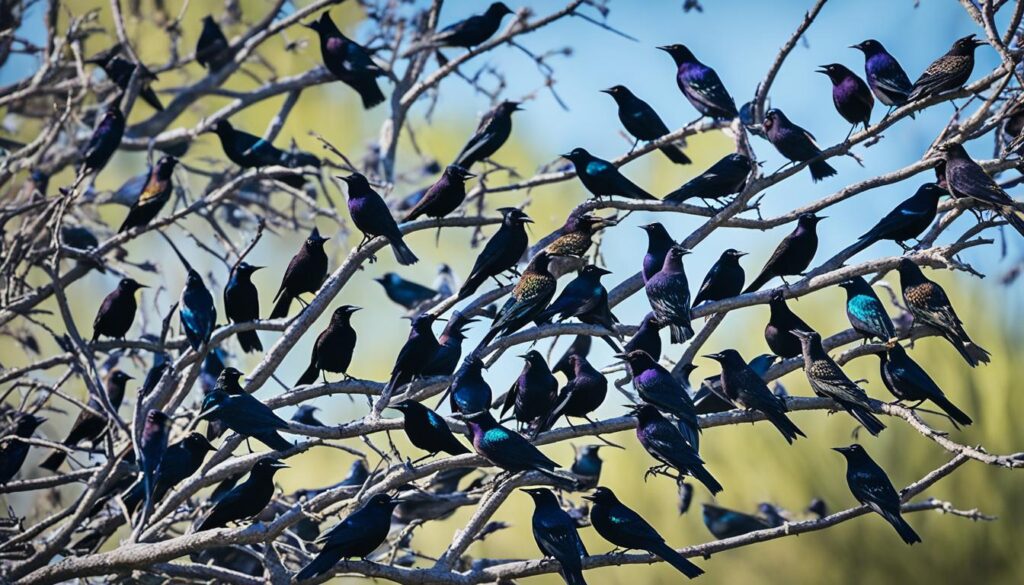
The Auditory Symphony of Grackles
Listening for distinctive sounds can help you spot grackles within these flocks. Grackles are known for their unique vocalizations, producing a combination of squeaks, croaks, and quick, high-pitched whistles. These auditory cues add to the overall vibrant and energetic atmosphere created by these flocking birds.
A Multitude of Starlings
Among the bustling group of birds, the European starlings stand out with their iridescent feathers and remarkable adaptations. While their appearance steals the show, the starlings contribute to the symphony of sounds with their distinct calls. Starlings produce a melodic stream of rattles, whistles, and purrs, adding their own unique harmonies to the chorus of bird voices.
In summary, grackles and starlings have a remarkable ability to flock together in massive groups, creating a mesmerizing display of coordinated flight and captivating sounds. These gatherings serve as a vivid reminder of the diverse and fascinating world of birds.
Grackle vs Starling Sounds
When it comes to sounds, European starlings and grackles have their unique vocal abilities. European starlings, in particular, are impressive mimickers. They can learn and imitate the songs of up to 20 other birds, showcasing their remarkable vocal talent. Their calls are characterized by a distinct stream of rattles, whistles, and purrs, creating a vibrant symphony in your backyard.
Grackles, on the other hand, have their own distinctive sounds. They produce a combination of squeaks and croaks accompanied by quick, high-pitched whistles. These vocalizations add an interesting layer of noise to the ambiance, making it easier to recognize their presence.
To get a better understanding of the unique sounds made by starlings and grackles, you can listen to their calls using our interactive audio guide below:
European Starling Calls
- Distinct stream of rattles, whistles, and purrs
- Imitations of other bird songs
Grackle Vocalizations
- Combination of squeaks and croaks
- Quick, high-pitched whistles
By familiarizing yourself with the unique sounds of these birds, you can enhance your birdwatching experience and better identify them in your backyard. Now let’s delve into the fascinating feeding behaviors of starlings and grackles in the next section.
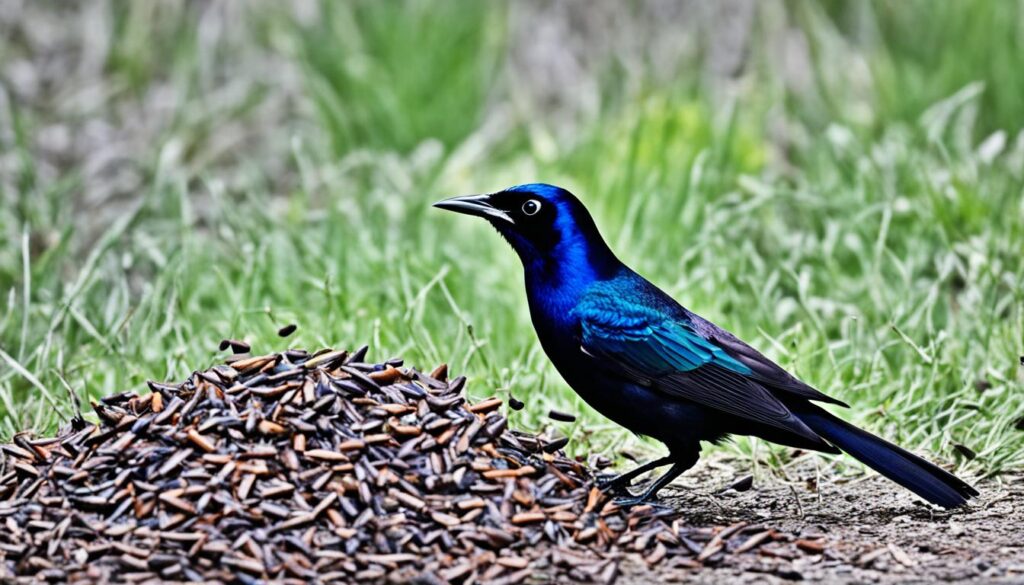
Starling and Grackle Feeding Behaviors
When it comes to feeding behaviors, both starlings and grackles display aggressive tendencies at bird feeders. These birds are notorious for monopolizing the food and causing disturbances among other bird species. It is important for us to understand their feeding behaviors and take necessary measures to manage their presence at feeders.
Feeder Raiding in Large Groups

Starlings and grackles are skilled at raiding bird feeders in large groups. They descend upon feeders in a frenzy, quickly consuming the available food. This behavior can disrupt the feeding patterns of other birds and may drive them away from the area.
These birds are highly adaptable and have learned to exploit human-provided food sources. As a result, they have become skilled competitors for feeder resources. Their ability to form formidable flocks can be overwhelming for smaller bird species.
Managing Their Presence
To manage the presence of starlings and grackles at bird feeders, consider implementing the following strategies:
- Use selective feeders: Opt for feeders that are designed to exclude larger birds like starlings and grackles. These feeders typically have small perches or mechanisms that prevent access to larger birds.
- Provide alternative food sources: Diversify the food offerings in your yard. Include options such as suet, fruit, or mealworms, which are less attractive to starlings and grackles but still appeal to a wide range of native bird species.
- Adjust feeder placement: Experiment with the placement of your feeders to make them less accessible to larger birds. Consider hanging feeders from thin poles or wires, away from trees or structures that could provide easy access to these birds.
By taking these measures, we can help create a balanced feeding environment for diverse bird species, ensuring equal access to food resources without overwhelming competition.
Starling vs Grackle Habitat and Range
When it comes to habitat and range, there are distinct differences between common grackles and European starlings.
Common grackles are a familiar sight in the eastern and midwestern United States year-round. They are well-adapted to a variety of habitats, from urban areas to open fields and woodlands. These resourceful birds can often be found near water sources such as marshes or wetlands.
On the other hand, European starlings are commonly sighted throughout the United States and southern Canada year-round. Originally from Europe, these nonnative birds have successfully established populations across North America. They are highly adaptable and can thrive in a wide range of habitats, including urban areas, farmlands, and grasslands.
Grackles extend their breeding range up to southern Canada, while starlings have a more expansive range that covers most of the United States and southern Canada.
To summarize:
- Common grackles: eastern and midwestern U.S., year-round, breeding range extends to southern Canada
- European starlings: United States and southern Canada, year-round
Understanding the preferred habitats and ranges of these birds can help in identifying them and creating bird-friendly environments in your backyard.
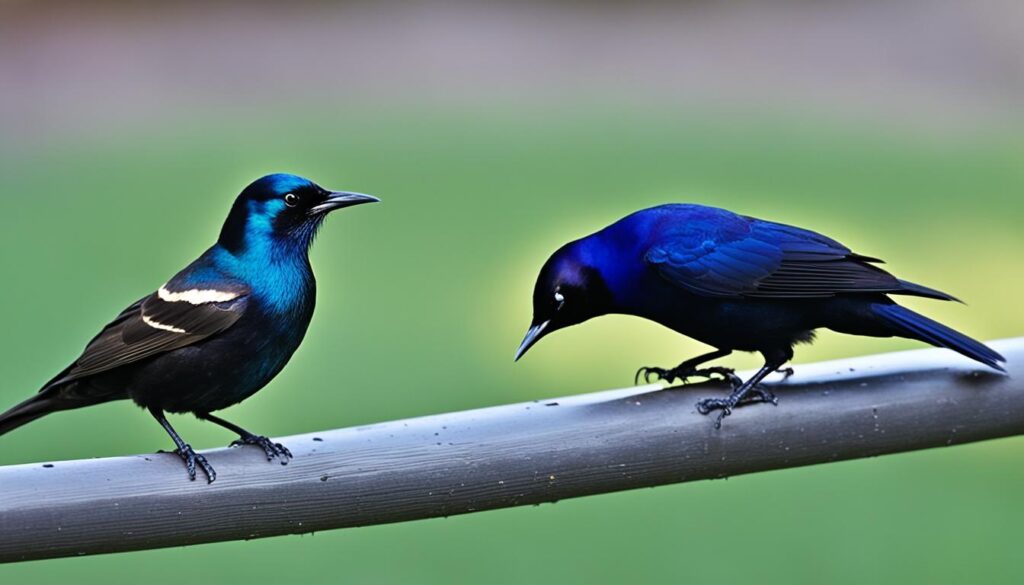
Distribution of Common Grackles and European Starlings
| Species | Habitat | Distribution |
|---|---|---|
| Common Grackle | Urban areas, open fields, woodlands | Eastern and midwestern U.S., breeding range extends to southern Canada |
| European Starling | Urban areas, farmlands, grasslands | Most of the United States and southern Canada |
Conservation Concerns for Starlings and Grackles
European starlings and common grackles are considered invasive species in some areas. As bird conservationists, we have identified several conservation concerns regarding the presence of these birds and their impact on native bird species.
One of the main concerns is their aggressive behavior at bird feeders. Starlings and grackles have been observed dominating feeders, often bullying other birds and hogging the food. This not only disrupts the feeding patterns of native bird species but also reduces their access to essential nutrients.
Furthermore, both starlings and grackles possess the ability to outcompete native bird species. Their adaptability and aggressive nature allow them to thrive in various habitats, giving them an advantage over other birds. This dominance can lead to a decrease in the population of native bird species, jeopardizing the overall biodiversity in our ecosystems.
“The aggressive behavior of starlings and grackles at bird feeders is a conservation concern as it disrupts the feeding patterns of native bird species.”
To address these conservation concerns, efforts are being made to manage the populations of starlings and grackles. Various strategies include bird feeder management techniques, such as using selective feeders and providing alternative food sources to attract and support native bird species. Additionally, promoting awareness about the negative impacts of invasive species and the importance of protecting native bird populations is essential to fostering conservation efforts.
Conservation Tips: Supporting Native Bird Species
There are several steps we can take to minimize the impact of starlings and grackles on native bird species and create a more balanced ecosystem in our backyards:
- Implement bird feeder management techniques, such as using baffles or weight-sensitive feeders that deter starlings and grackles while allowing access to smaller native birds.
- Choose native plants and create a diverse habitat that provides food, shelter, and nesting opportunities for a wide range of bird species.
- Keep bird feeders clean to prevent the spread of diseases that can affect all bird populations.
- Remove or modify nesting sites that may attract starlings and grackles, such as crevices in buildings or cavities in trees.
- Participate in citizen science programs and contribute to data collection efforts that help track and monitor bird populations.
By following these conservation tips, we can actively contribute to the protection and preservation of native bird species, ensuring a harmonious coexistence between different bird populations in our surroundings.
| Conservation Concerns | Solutions |
|---|---|
| Aggressive behavior at bird feeders | Implement bird feeder management techniques |
| Competition with native bird species | Choose native plants and create a diverse habitat |
| Disruption of feeding patterns | Keep bird feeders clean and disease-free |
| Impact on overall biodiversity | Remove or modify nesting sites that attract starlings and grackles |
| Participate in citizen science programs |
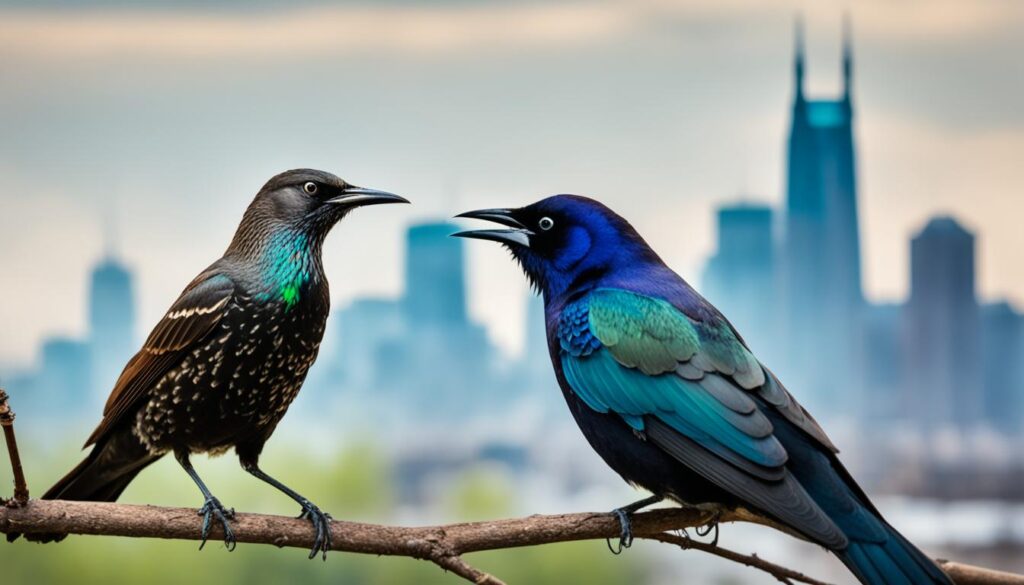
Starling and Grackle Interactions with Other Birds
Due to their large numbers and aggressive behavior, starlings and grackles often compete with other bird species for resources such as nesting sites and food. This can have significant impacts on the local bird populations and ecosystem dynamics.
Starlings, with their highly adaptive nature, have been known to displace native birds from their preferred nesting locations. They compete fiercely with cavity-nesting birds like woodpeckers, bluebirds, and tree swallows, often taking over their nests and driving them away. As a result, these native bird species may struggle to find suitable nesting sites and reproduce successfully.
Starlings are notorious for evicting native birds from their nesting cavities, leading to a decline in native bird populations.
Grackles, on the other hand, are known for their aggressive foraging behaviors. They often form large flocks that can overpower and drive away smaller bird species from feeding areas, creating intense competition for limited food resources. This can disrupt the feeding patterns and behaviors of native birds, making it more challenging for them to find enough food to survive and raise their young.
In some cases, starlings and grackles can even resort to parasitic behavior, attempting to lay their eggs in the nests of other bird species. This behavior, known as brood parasitism, can have adverse effects on the host species, as they end up investing valuable resources in raising the young of a different species.
Overall, the interactions between starlings, grackles, and other bird species can influence the composition and dynamics of the local bird community. Understanding these interactions is crucial for implementing effective conservation strategies to promote the well-being of native bird species and maintain the ecological balance.
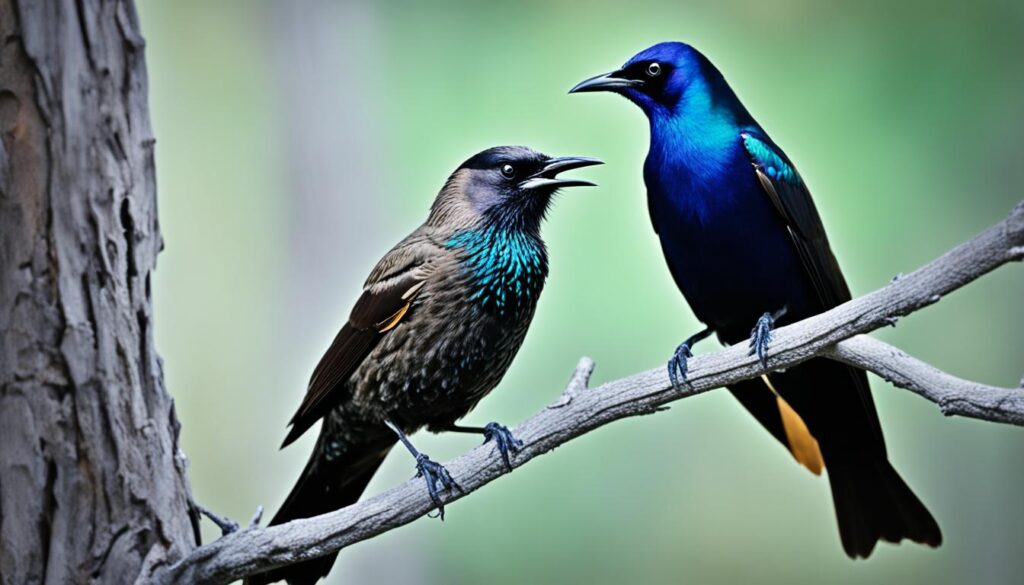
Protecting Native Bird Species
To protect native bird species from the negative impacts of starlings and grackles, we can take several proactive measures:
- Provide suitable nesting habitats for native cavity-nesting birds. Install nest boxes designed for native species such as bluebirds and tree swallows, ensuring that the entrance holes are sized to prevent larger birds like starlings from entering.
- Implement feeding strategies that discourage starlings and grackles. Use feeders with weight-sensitive mechanisms that close when heavier birds land on them, preventing access to the food. Alternatively, use tube feeders with small perches that accommodate smaller bird species but deter larger birds.
- Create bird-friendly landscapes. Plant native vegetation that provides food sources like berries, seeds, and nectar, attracting a diverse range of bird species. Avoid using pesticides and chemicals that can harm birds and their habitats.
By taking these steps, we can foster a welcoming environment for native bird species and mitigate the impact of starlings and grackles on their populations.
Attracting Native Bird Species to Your Backyard
To attract native bird species to your backyard, we need to create a welcoming environment that meets their specific needs. Here are some tips to help you attract a diverse range of beautiful birds:
Create a Diverse Habitat
Native birds thrive in habitats that offer a variety of food sources, shelter, and nesting sites. Planting native trees, shrubs, and flowers will provide natural food and nesting opportunities. Additionally, consider adding birdhouses, nesting boxes, and bird baths to attract different bird species.
Offer Food Sources
Providing a diverse range of food options is essential to attract native bird species. Incorporate native plants that produce berries, fruits, or nectar to attract birds that rely on these food sources. Installing bird feeders with appropriate feeds can also attract a variety of species.
Avoid Chemicals and Pesticides
Chemicals and pesticides can be harmful to birds and their food sources. Opt for organic pest control methods and avoid using pesticides in your garden. This will help ensure a safe and healthy environment for the native bird species you are trying to attract.
“Creating a diverse and bird-friendly backyard habitat is crucial for attracting a wide range of native bird species. By providing a variety of food sources, planting native plants, and avoiding harmful chemicals, you can create a haven for these beautiful creatures.”
Implement Water Features
Adding a water feature, such as a bird bath or a small pond, can attract birds that rely on water for drinking and bathing. Ensure the water source is clean and regularly maintained to provide a safe and inviting space for the birds.
Be Patient and Observant
Remember that attracting native bird species to your backyard takes time. Be patient and observe the birds that visit your garden. By understanding their preferences and behaviors, you can make further adjustments to make your backyard even more enticing for them.
By implementing these tips, you can create an inviting sanctuary for native bird species in your own backyard. Enjoy the beauty and serenity of these wonderful creatures as they grace your outdoor space with their presence.
| Native Plants | Food Sources | Attracted Bird Species |
|---|---|---|
| Oak tree | Acorns provide food for woodpeckers, nuthatches, and jays | Woodpeckers, nuthatches, jays |
| Goldenrod | Produces nectar that attracts hummingbirds and butterflies | Hummingbirds, butterflies |
| Serviceberry shrub | Berries are enjoyed by thrushes, waxwings, and finches | Thrushes, waxwings, finches |
| Milkweed | A food source for monarch butterflies and their caterpillars | Monarch butterflies |

Note: The image above showcases a variety of native bird species that can be attracted to your backyard by following the mentioned tips.
Conclusion
In conclusion, understanding the key differences between starlings and grackles is essential for identifying these unique backyard birds. While they may have similar appearances, it is their behaviors, sounds, and habitat preferences that set them apart. By familiarizing ourselves with these characteristics, we can create a welcoming environment for a variety of bird species in our own backyard.
Starlings, with their purplish green iridescence and white spots, and long, thin yellow beaks, bring a touch of elegance to any landscape. Meanwhile, the shiny feathers, bluish heads, and bronze bodies of grackles add a dynamic energy to the scenery. Each species has its own distinctive sounds, with starlings impressively mimicking the songs of other birds and grackles producing a combination of squeaks, croaks, and high-pitched whistles.
When it comes to habitat and range, grackles are commonly sighted in the eastern and midwestern United States year-round, while starlings have extended their presence throughout the U.S. and southern Canada. Although both species may be seen flocking together in large groups, they can also present challenges for other bird species and backyard feeders due to their aggressive feeding behaviors. Conservation efforts are underway to manage their populations and preserve the balance of ecosystems.
By grasping the intricacies of starlings and grackles, we can better appreciate the diversity of birdlife in our backyards and take steps to attract a wider range of native bird species. Creating a habitat enriched with native plants, diverse food sources, and a chemical-free environment will ensure we provide a welcoming haven not just for starlings and grackles, but for a multitude of bird species.
